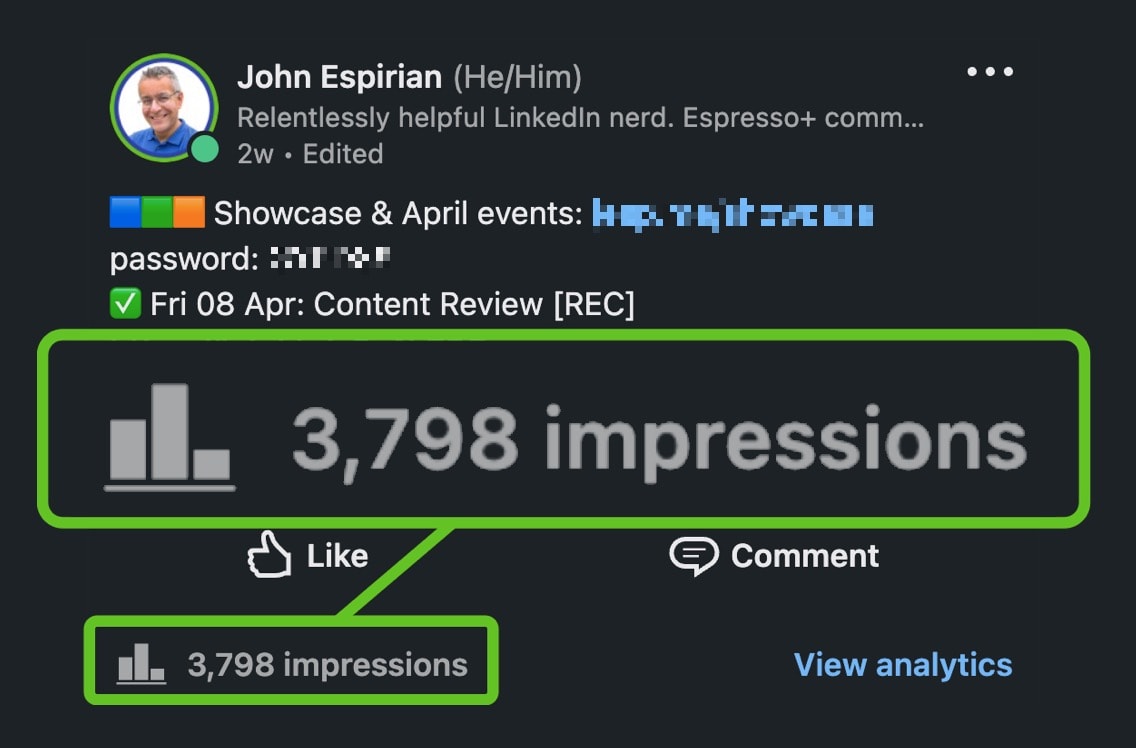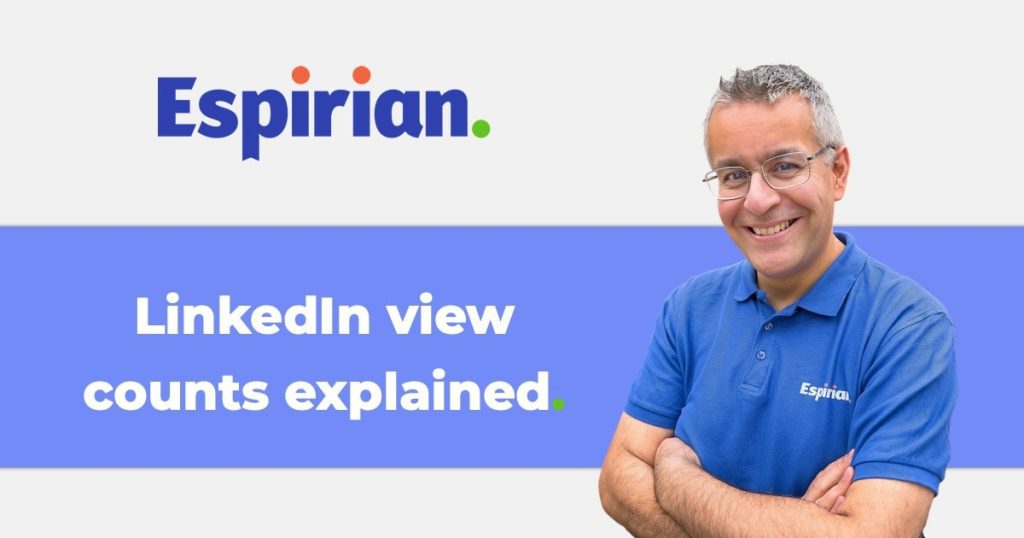Not all LinkedIn views are equal.
On LinkedIn, not all views count the same way. Let’s look at how they differ and what sort of views really matter.
My current view stats are shown below. You’ll have to read the rest of the post to understand the differences!
| Posts | Reactions | Comments | Views | Shares | |
|---|---|---|---|---|---|
| Text | 209 | 118 | 101 | 8131 | 3.4 |
| Image | 485 | 87 | 79 | 5287 | 1.3 |
| Video | 222 | 107 | 89 | 2401* | 2.2 |
| Document | 36 | 124 | 120 | 11566 | 4.9 |
Source: 956 posts analysed between August 2018 and April 2022. Absolute post counts in first column. Mean average counts in the rest of the table.
* Must be multiplied by 5 to be comparable to other view counts in this table. See explanation
- Impressions versus views
- Post views
- Article/newsletter views
- Video views
- How much are video views really worth?
- Do shared video post views add to the original post’s view count?
- Profile views
- Let’s wrap up
Here’s an audio version of this post:
Impressions versus views.
An impression means some piece of content was loaded on the page such that it could have been viewed. It’s a bit like opening a newspaper to a page full of ads: all of the ads on that page have been “loaded” and are ready to be read.
A view means the content was viewed. For videos, the count happens after only 3 seconds, so we can’t be sure it was a meaningful view. In other words, you really did glance at a specific ad on the newspaper page – but perhaps not for long enough to take it in properly.
For other post types, judging whether content has actually been viewed is tough: LinkedIn needs to rely on things such as clicks of “see more” links to assess whether the viewer has taken real interest in the content.
Potentially, they might measure how long the content was visible for by recording your scrolling activity. The technology exists to do this; whether it’s used on LinkedIn is another matter.
Post views.
Posts are the short status updates shown in the LinkedIn home feed. They used to be limited to 1300 characters and changed to 3000 characters at the end of May 2021 (see LinkedIn help article).
LinkedIn counts a post view – strictly speaking, it’s an impression – every time a post is presented in someone’s home feed. It is not a measure of whether people clicked “see more” or paid any attention to the post at all, only that the content was loaded in the feed.
That means the content might not have been read – it was just shown.
If you’re thumb-scrolling through your feed at a million miles an hour, you’re adding an impression to each of those posts even though you haven’t stopped to read them.
Because of that, post views/impressions aren’t a great indicator of engagement from your audience.
In March 2022, LinkedIn started showing impression counts inside groups. This is important because for the first time we can be sure that impression counts are not the same as unique views.
Here’s an example from the Espresso+ community, which had fewer than 200 members at the time this screenshot was taken. And yet the impression count was in the thousands.

This example confirms that the impression counter was increasing each time the post was loaded. Working out how many unique views there were of this or any other post therefore becomes almost impossible. Keep that in mind before you say “X thousand people saw my post!” – they probably didn’t.
Why do text-only posts perform so well on LinkedIn?
I’ve seen that text-only posts tend to perform better on LinkedIn than other content types.
This confuses people who are usually taught that posts with images will perform best. That’s true on other social media but not so much on LinkedIn.
Here’s why I think LinkedIn like text-only posts so much:

Onscreen space.
Text-only posts take up less room onscreen than other types of content, so LinkedIn can fit in more content in the same space.
That gives them more chances to hook you in with an interesting-looking post.

Reduced bandwidth.
Text-only posts use less bandwidth and are therefore easier for LinkedIn to serve to their users.
Bandwidth seems less of an issue on other platforms, but on LinkedIn we see an environment where not everyone has access to live video, and that could be because of the strain it would put on their system.

Perceived professionalism.
Text-only posts may feel more “professional” for people to be consuming and interacting with in a shared work setting.
Perhaps don’t want work colleagues looking over their shoulder and seeing them checking out lots of images and videos all the time.
Article/newsletter views.
Articles and newsletters are longform pieces of writing (up to 120K characters) that are LinkedIn’s equivalents of blog posts.
Article and newsletter views are counted only when someone clicks through to read the article or newsletter.
This could be via a link in your profile or in a post, but also from links in emails, Google searches or even direct traffic.
Unlike post views, article and newsletter views are the result of a conscious decision by the viewer. No one views a LinkedIn article or newsletter by accident.
LinkedIn treats articles as though they’re the same as external content. If you want eyeballs on your articles, you need to promote hard on LinkedIn and elsewhere. Without promotion, don’t expect your articles to get a lot of views. This isn’t quite the same for newsletters, as subscribers should receive a notification about new episodes, as well as an email for each newsletter.
As articles and newsletters are weightier than posts, even a small number of these views can help build your authority and earn new leads into your business.
To date, I’ve published 36 articles on LinkedIn, with an average view count of 237. If I ignore older articles, my average is a little over 500. Nothing special but it’s OK.
For more information, see my piece in defence of LinkedIn articles.
Video views.
Videos here means the movies/clips shared directly in LinkedIn posts. These are called “native video” posts.
In contrast, “external video” posts contain links to third-party video sites such as YouTube and Vimeo.
The net result of both looks about the same – you see a post containing a video.
But LinkedIn’s algorithm doesn’t like links to external content – so it’s much better to post native videos rather than external videos.
Native video views are counted after the content is played for 3 seconds.

That means a quick thumb-scroll past a video isn’t going to count, but if you pause and give the content even brief attention, that will count.
The 3-second rule means that video view counts will almost always be lower than normal post view counts.
Still, these video views are a signal of attention and therefore could be seen as more valuable views than post views.
Video view counts used to be shown publicly when a video had received more than 500 views.
The introduction of creator analytics in mid 2022 means this public view count is no longer displayed, so you can’t see how well someone else’s video is performing (other than seeing the number of reactions, comments and shares, as usual).
How much are video views really worth?
My January 2022 experiment on my company page shows that a video view is worth the equivalent of about 5× that of a post view.
In other words, a video receiving 3K views might be comparable with a normal post that receives 15K views.
Here’s the data from my experiment, which shows the relationship between video views and post impressions.
| Post | Impressions | Views | Ratio |
|---|---|---|---|
| 01 | 197 | 34 | 5.8 |
| 02 | 448 | 92 | 4.9 |
| 03 | 661 | 136 | 4.9 |
| 04 | 500 | 75 | 6.7 |
| 05 | 81 | 18 | 4.5 |
| 06 | 116 | 22 | 5.3 |
| 07 | 198 | 48 | 4.1 |
| 08 | 186 | 51 | 3.6 |
| 09 | 403 | 77 | 5.2 |
| 10 | 132 | 37 | 3.6 |
| 11 | 62 | 23 | 2.7 |
| Total | 2984 | 613 | 4.9 |
I did my experiment by posting videos to my company page. The analytics there let me see how many times each video was loaded into people’s feeds (impressions) and how many times the videos were actually watched for a minimum of 3 seconds (views).
The average ratio came out to 4.9:1. This means that for the publicly reported view count, you’d need to multiply by 4.9 (on average) to get the number of impressions for that post.
Here’s some newer data from an experiment I did on my personal posts in June 2022:
| Views | Impressions | Ratio |
|---|---|---|
| 1000 | 5078 | 5.08 |
| 1137 | 7175 | 6.31 |
| 910 | 4556 | 5.01 |
| 4587 | 17268 | 3.76 |
| 838 | 5208 | 6.21 |
| 1129 | 6550 | 5.80 |
| 944 | 5881 | 6.23 |
| 1002 | 6468 | 6.46 |
| 1038 | 7063 | 6.80 |
| 1345 | 8305 | 6.17 |
| 994 | 5001 | 5.03 |
| 966 | 6492 | 6.72 |
| 628 | 3563 | 5.67 |
| 940 | 9899 | 10.53 |
| 667 | 5994 | 8.99 |
| 4727 | 17139 | 3.63 |
| 773 | 4041 | 5.23 |
| 928 | 4211 | 4.54 |
| 1362 | 6997 | 5.14 |
| 1318 | 6714 | 5.09 |
| 1935 | 10405 | 5.38 |
| 1076 | 6968 | 6.48 |
| 1290 | 6894 | 5.34 |
| 2055 | 12169 | 5.92 |
| 1278 | 9247 | 7.24 |
| 932 | 6292 | 6.75 |
| 752 | 4288 | 5.70 |
| 1770 | 9672 | 5.46 |
| 843 | 4920 | 5.84 |
| 1029 | 6716 | 6.53 |
| 2925 | 10832 | 3.70 |
| 1145 | 6569 | 5.74 |
| 892 | 4536 | 5.09 |
| 1755 | 5347 | 3.05 |
| 546 | 2551 | 4.67 |
| 861 | 3995 | 4.64 |
| 1344 | 6153 | 4.58 |
| 460 | 2450 | 5.33 |
| 1300 | 6080 | 4.68 |
| 938 | 4868 | 5.19 |
| 5205 | 18943 | 3.64 |
| 57564 | 293498 | 5.10 |
This data shows that LinkedIn video impression counts are 5× higher than view counts.
Why does that matter?
Because every other type of shortform post (text/image/document/poll) is measured on impressions.
So, comparing video posts’ view counts with every other posts’ impressions count isn’t a fair comparison.
By working out what a video post’s impressions count is, you can then make a fairer comparison.
In short:
In my experience, anything over 1K is good for video views. Go beyond 5K and you’re really doing well.
While video view counts might look low at first glance, there are things that these numbers can’t reflect:
- brand awareness.
- tone of voice.
- emotional connection.
- memorability.
Video has the power to cut through and really reach people in a way that text alone can’t, and it’s made a big difference to my success on LinkedIn.
Do shared video post views add to the original post’s view count?
I don’t think so. I’ve seen separate numbers reported on other shared posts, which makes me think that those numbers wouldn’t also be added to the original video’s view count.
LinkedIn don’t confirm the way it’s meant to work, so I’m taking my best guess on this one.
Profile views.
This is where view counts get interesting.
A profile view is one where someone has consciously opted to look at your public profile. They might already be connected with you or not. Either way, getting more profile views is a good sign.
On other platforms, this could be a bit of a vanity metric, but on LinkedIn, people are apt to do business.
If someone’s there checking out your profile, that could mean that they’re interested in what you sell or what service you can provide to them.
On the Home feed of LinkedIn, there’s a link that lets you see Who’s viewed your profile.
Premium members get more data than free users:
- Premium: 90 days of profile view data, plus graph to show view trendline
- Free: last 5 profile viewers only, with no graph
I mention this and other differences between the accounts in my LinkedIn Premium review.
LinkedIn profile views are like lottery tickets – the more you get, the more chance you have of winning the prize (doing more business).
And that’s what I’ve seen for my copywriting services. I’m now getting 45× more profile views than I did at the start of 2017, and that’s meant a lot more leads into my business and ultimately more money in the bank.
So, of all the view types I’ve mentioned, profile views are probably the most important to keep an eye on.
When you load your home feed in LinkedIn on the desktop, look at the left-hand panel to see a count of your profile views over the last 90 days.

Let’s wrap up.
Not all views count equally on LinkedIn, so it’s not right to compare, for example, post views with article views.
As with all things on LinkedIn, you can improve your stats by:
- writing a good profile headline and summary.
- showing up consistently with helpful posts, articles, videos and comments.
Profile views matter most of all the view counts – they’re the lottery tickets you want to maximise, so that you have a greater chance of doing more business.


